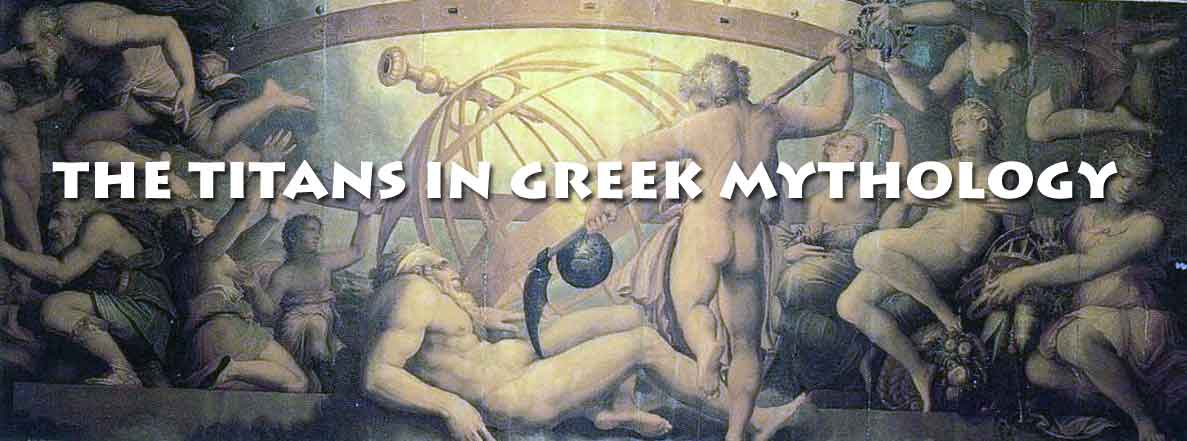Battle of the Titans agains the Gods in Greek Mythology

On Zeus’ side were his brothers and on the side of Cronus were most of the Titan brothers. They chose the almighty Atlas, the son of Iapetos, for their leader. Some of the Titans, however, supported the gods. These included Oceanus and his daughter Styx, her children Kratos (Power), Bia (Violence), Zelus (Zeal) and Nike (Victory).
Furthermore, although one of Iapetos’ sons, Atlas, had sided with the Titans, another son, Prometheus, sided with the gods. Not surprisingly Gaea, the mother of the Titans, supported her grandson Zeus and prophesised that they would only be victorious if the Cyclops and the Hecatonicheires were set free from their prison in the underworld. Consequently, Zeus descended into the deep abyss of Tartarus and released the one-eyed Cyclops and the hundred armed Hecatoncheires, drawing them into an alliance with him to fight against Cronus. For their allegiance Zeus promised them great benefits if he became ruler. In return, the Cyclops gave the power of thunder, lightening and thunderbolts to Zeus. To his brother Poseidon they gave the trident and to Hades they gave the helmet of darkness, a hood, fashioned from dog skin which makes the wearer invisible.

At last the Titans were defeated and they were rounded up and sent beneath the earth to Tartarus where they were kept in chains and surrounded by a bronze fence and a triple wall. To this day, among the dreadful vapours and dense shadows, they languish still. Only a few were spared. The Titanesses were allowed to go free because of the help given to Zeus by Rhea. The appointed leader of the Titans, Atlas, was given the harshest punishment of all. Instead of being chained up in Tartarus he was exiled to the ends of the earth and was condemned to hold the earth and the sky upon his shoulders.
Thus, the old divine order was incarcerated deep in the bowels of the earth, whilst the victorious Olympian gods ascended into the sky to bring new values and new concepts into the world. To symbolise and remind both gods and humans of his superior powers, Zeus took the stone, which his father had swallowed believing it to be the infant Zeus, and sent it to the Oracle of Delphi at the foot of Mount Parnassus. For centuries afterwards mortals would come to worship and anoint it with oil and make offerings upon it.

Titans and Titanides were not the only children of Heaven and Earth. Near them there were other demons, such as the Heavenly Cyclops. They called them heavenly because they were sons of Uranus. Argis, Steropis and Vrontis were the three spirits of storm, lightning and thunder, tasked to make in their underground workshops the lightning for the gods. The workshops were in Lemnos or Sicily or in the seventeen Aeolian islands, also called Liparas, in other words, in the volcanic places.
In addition to these Cyclops, Uranus and Earth gave birth to the three Giants, Hundred hands Monsters with fifty heads, Kattos, Vriareo, and Gyes. Later on, other Giants were born from the Earth, huge and violent. People did not yet exist. And the Greeks imagined them as monstrus forms with a huge, snaking body. They depicted them over the centuries in the fronts of their churches: figures with their head, chest, shoulders and hands announcing the future people.
The world waited for man. But the mythology tellers do not agree with the way the genus of mortals was presented on Earth. Sometimes they said the first man was indigenous, that he came out of the earth. In Argos, the first person was called Foroneas. His mother was the nymph Melia and his father Inachus, the god of the river that rains Argolida. As we know, rivers bring people cool, water for their crops, to wash and drink. So, naturally, people build their villages on the river banks. In the imagination of the people of Argolis, their ancestor was born from the river and from a tree.
All river gods were sons of the Ocean. Like their father, they were immortal. Nymphs, especially the Dryades, were also born by the blood of Uranus. But they were not immortal. They could only live for a long time, as long as the life of ten palm trees.Thry were dead only the day when their tree was drowned and fell.
